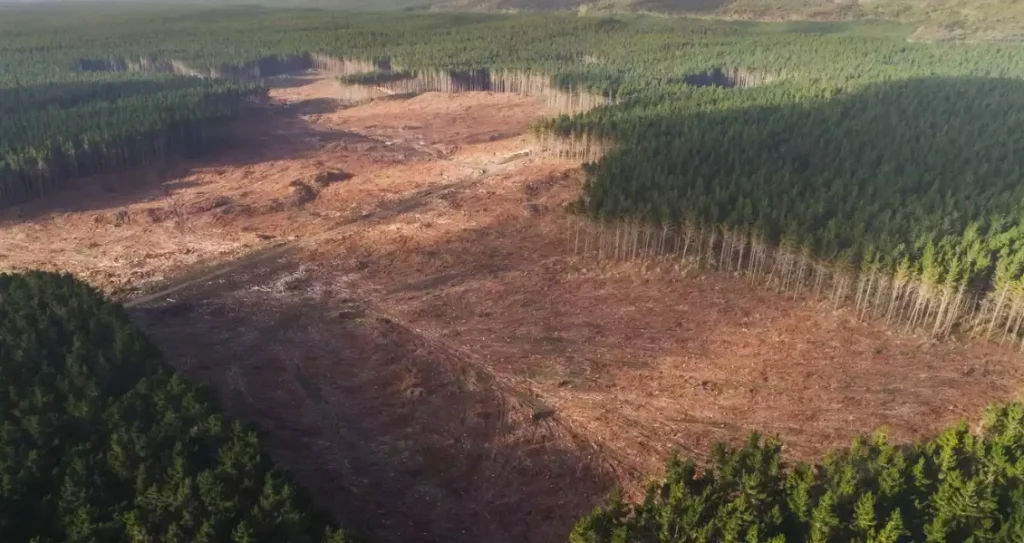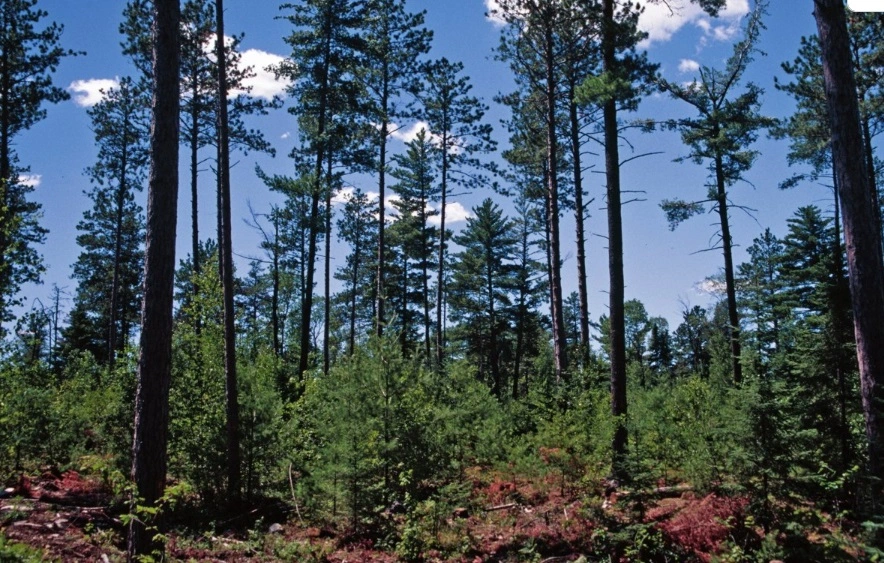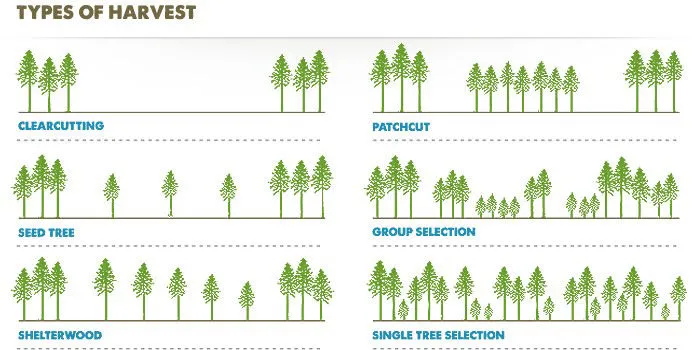
What is Timber Harvesting
Timber harvesting is a forest management procedure that requires careful planning and strict devotion to the chosen methods. Otherwise, it can cause important economic losses to forestry and harm the environment.
It can be used to achieve several different objectives for the woodland property. Forest owners may choose to cut trees on their property to produce income from timber. Others might want to create wildlife habitat, develop a fire-resilient forest, accomplish for older forest structure, or a combination of those.
In any of the cases, there are many things to contemplate when managing a timber sale. Harvesting wood products is a significant part of the forest community’s multi-use approach to being responsible land owners. The timber on forest lands is growing in volume, in age, and value every year.
If timber harvesting has been done carefully, it can result in the creation of younger forests, thus increasing the age and size class variety of our landscape. It also generates revenue to further support the forest community’s mission. Using a detailed natural resource inventory, our foresters collect applicable data and use the best available silvicultural practices to develop a management plan for each property.
This management plan guides the timber harvests that will be carried out which has the goal of sustainably and thoughtfully managing the land it covers. Timber harvesting is frequently used as a method of meeting other goals for management including the maintenance of plant biodiversity, creation of wildlife habitats, and advancement of recreational opportunities.
Reasons for Timber Harvesting
Forestry needs the right approach to the care and restoration of trees. Excessive harvesting causes disastrous impacts on the environment if timber harvesting is not tackled and the state of the forest is not maintained. Some of the reasons for timber harvesting are as follows;
Trees Reach at Maximum Weight
When developed trees have reached their total weight, their growth, and health both decrease. That is why the most noteworthy revenue is provided by selling wood from mature trees. In the meantime, old forests with dead trees provide habitats for many wild animals, such as spotted woodpeckers, flying squirrels, owls, and raccoons. Therefore, some parts of the forest must be left during logging.
To Improve Forest Health and Value
Removal of diseased and old plants adds to crop trees growth and increases their worth. Using the crop tree release mechanism, we can increase the productivity of individual plants and expand the habitat of wild animals. Therefore, foresters often leave species that bears, grouse squirrels, deer, and others depends for food when harvesting timber.
In spite of the apparent benefits, extreme timber harvesting is harmful. If there are not sufficient plants to cover the area, growth per acre will decrease. Furthermore, the quality of many trees grown outdoors is worsening. Therefore, foresters maintain planting density optimum for particular species and age plants.
Creating a Fire-Resistant Forest
Although all forest is vulnerable to fire, some methods of timber harvesting can considerably reduce this disaster or its consequential risk. One of the most common methods is to increase the distance between tree canopies using timber harvesting. It is very difficult for fires to extend if they are located farther apart, even with strong winds. Also, fire-resistant trees should be left intact, when choosing plants for logging large.
Encouraging Regeneration
For trees to grow rigorously, it is necessary to encourage their regeneration. So, foresters need to create the circumstances required for a particular regeneration during logging. For instance, paper birch and aspen need plenty of sunlight. Others, for example, beech and red spruce, need partial shade. The third, so-called tolerant, plant species grow well in both conditions.
Regeneration cutting hastens a different species’ growth. So, timber harvesting with clear-cutting is suitable for encouraging paper birch or cherry. The elimination of challenging seedlings and shrubs can help other species. In the meantime, it is essential to control trees’ conditions for regeneration to be successful. For instance, it is best not to do any actions if the plants cannot produce the required seeds for recovery.
Timber Harvesting Methods
There are different methods used to harvest timber. In this section, some main methods are discussed;
Clear-Cutting of Timber
The clear-cutting technique involves all plant removal in the forest area. Thus, foresters replicate natural disaster results, the biological mechanisms of this process. This method is most operational on species that need full sunlight such as cedar pine, maple, paper birch, and eucalyptus.

Shelterwood
The crux of this timber harvesting method is the removal of mature trees for several collections within 10-15 years. It creates a roof over for shade-tolerant seedlings like red spruce and provides food sources for wildlife. Shelterwood is best-suitable for plantings from predominantly mature trees.

Seed Tree
According to this timber harvesting method, foresters leave more than five trees on the cut area remotely from each other which produces seeds for natural reforestation, and in the future, these plants can act as a woodpecker habitat. To harvest timber this way, the most suitable are plants with high sowing capacity, growth rates, and wind resistance.
Group Selection
This is a small-scale clear-cutting method when a stand is cut down over 4 or 5 decades by groups of trees. A cut-down area depends on a grown plant type, openings of less than one-quarter of an acre are appropriate for shade-tolerant trees and larger spaces for sun-loving trees. As a part of selective logging, this way to harvest timber is used to collect high-quality logs and is one of the most costly methods.
Single-Tree Selection
This approach is the most focused among major methods of timber harvesting. It involves the removal of individual mature, competing, or low-quality trees. Among the advantages is continuous wood production. However, this way of harvesting dodges damaging the remaining plants, best for small areas with shade-tolerant species. For sun-loving trees, there must be a different way.

Process of Timber Harvesting
Nevertheless of chosen ways to harvest timber, there are usually three main stages of harvesting that are, preparation, operations, and post-harvesting.
Preparation
There are different goals for harvesting timber:
Prevention of tree diseases, recreation, habitat improvement, and financial income. However, irrespective of this, the preparation step includes:
- Creation of high-accuracy topographic maps indicating the location of the most important natural and artificial objects (roads, crossing streams, bridges, and ecologically vulnerable areas).
- To do a forest inventory to assess potential harvesting timber volumes and get information on species composition and the most revenue-generating commercial areas.
- Stock mapping and tree classification to locate desired plants and audit to meet market needs.
- Planning for new roads and stream crossings to reduce costs and increase productivity.
- Defining no-go areas to preserve biodiversity and secure timber harvesting processes and the definition of barrier zones for the conservation of the environment and cultural sites.
Carrying out these preparatory activities permits you to optimize resources and organize additional stages most efficiently.
Timber Harvesting Operations
This process itself begins with the selection of appropriate machinery. It allows you to minimize environmental damage and achieve your goals faster. The logging equipment includes machines for cutting down trees and their further transportation. The final selection of machinery depends on the timber harvesting technique.
The next step is the building and maintenance of roads and log stairs. These activities affect work efficiency, financial costs, and the environment’s state. Next, it is essential to determine the timing of timber harvesting operations, organize the transportation of logs with minimal impact on soil, and, if necessary, instruct workers. Another essential operation is the directional felling of trees that avoids damage to remaining plants, keeps workers safe, and simplifies warehousing.
Post-Harvesting
After carrying out all harvesting procedures, it is necessary to instrument some measures to eliminate the production consequences:
- Closure of roads and slide trails for stabilization of ground and water movement.
- Drainage of waterfronts and mines, as well as, if necessary, restoration of vegetation.
- Cleaning of the campsite.
- Representation of a report on post-harvest inventory and analysis of the forest state.
- The forest owner and its manager usually carry out forest management activities.
A Long-Term Perception: Sustainable Timber Harvesting
Sustainable timber harvesting methods add not only to tree regeneration but also to the health of the forest. They include keeping the best trees until healthy and young plants grow or abolishing all vegetation to eliminate competition for new shoots.
This timber harvesting type often differs from the so-called commercial clear-cutting, leaving a few trees. Unluckily, most frequently, such plants are slow-growing and weak. It harmfully affects the health of the young plants, it become more susceptible to diseases and pests.
The commercial type is popular because it provides revenue in the shortest possible time. Sustainable timber harvesting is more profitable in the long run as it produces better-quality trees. Thus, it is a more valuable way for forestry.
Forest Monitoring Can Assist Timber Harvesting
The Forest state analysis, and the influence of a timber harvesting plan, require significant efforts from the forest- and landowners and the companies engaged in its clear-cutting. Forest monitoring software allows you to enhance forestry operations and reduce environmental and economic risks.
Monitoring of Illegal Cuttings
Illegal cutting causes severe losses for forest owners. Those who do illegal cutting can be government, utility, or private individuals. Illegal harvesting is often go with by significant damage to the ecosystem, as environmental problems are completely ignored. Different forest monitoring software helps to observe woodlands repetitively. It does not need any field trips and helps save time and resources.
Quality Monitoring of Timber Harvesting
When approving forest logging, forest owners always outline the area set aside for timber harvesting. Sometimes, there are barrier zones for cutting down if a decided timber amount has not been reached in the selected location or if part of the area was in a hard-to-reach place. Also, a forest owner can outline areas in which felling can never be carried out. Since forest areas are usually enormous, monitoring whether a timber harvesting contractor fulfills territorial restrictions is challenging.
Remote sensing, mainly satellite technology, plays a progressively important role in various industries. Since forestry is no exemption. Its comprehensive functionality pays to sustainable forestry management and the entire industry.
An article of timber harvesting and silviculture at university of Hampshire site can be accessed from https://extension.unh.edu/resource/timber-harvesting-and-silviculture
 The Climent Respect your roots, Protect your planet
The Climent Respect your roots, Protect your planet
